Can Isometrics Cure High Blood Pressure?
By Paul “Coach” Wade
If you’ve been in the training world for a while, you’ve probably heard the dusty myth: isometrics is bad for your blood pressure.
Well, it’s just that—a myth.
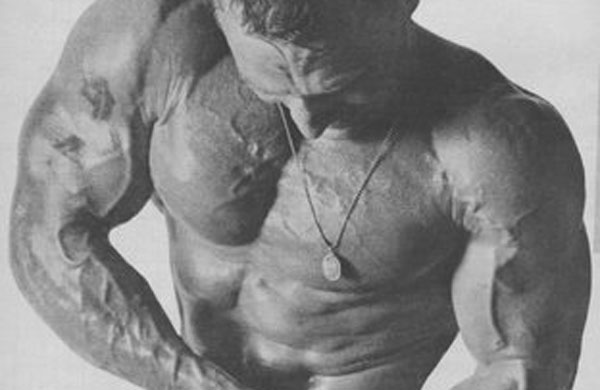 Bodybuilding can make your veins pop—but is it bad for the blood pressure? (Image: Chuck Sipes)
Bodybuilding can make your veins pop—but is it bad for the blood pressure? (Image: Chuck Sipes)
This particular little fallacy is a leftover from a very specific time period—the twentieth century. Before that, the notion that heavy exercise might be bad for the body’s systems would have been seen as crazy. The Greeks and Romans believed that heavy exercise was not only good for your body, it was a social duty—citizens should be strong and healthy. Similar convictions in the benefits of heavy exercise can be found in the Dark Ages and Renaissance, right up to the twentieth century.
…So, what happened in the twentieth century?
What happened was that blood pressure (BP) became a dominant concept in the minds of physicians. BP is a fairly recent metric. Blood pressure was only measured in animals (horses, in fact) as recently as the eighteenth century. (Tragically, the original process was low-tech to the point of being barbaric—it involved fitting brass pipes onto the arteries of the animals. When the pipes were removed, the horses inevitably bled to death.)
The first human measurements of blood pressure weren’t taken until halfway through the nineteenth century, and the sphygmomanometer (blood pressure cuff) as we know it today wasn’t invented until the twentieth century; even then, it took decades to become widespread. But as soon as it was, "blood pressure" became a standard metric for human health.
Blood pressure as a concept was true breakthrough. It allowed medics to visualize the circulatory system like any set of pipework for fluids; liquid runs through at a certain pressure—if the pressure is too low, the system won’t run (lack of blood to organs, syncope, etc). If the pressure is too high, it will damage the pipework over time; a pipe might spring a leak, or even burst (strokes, aneurisms, etc). So, we want people to have a nice, moderate blood pressure. A little on the low side is fine, but high BP must be avoided at all costs. This all makes sense, and was certainly the consensus by the 1950s.
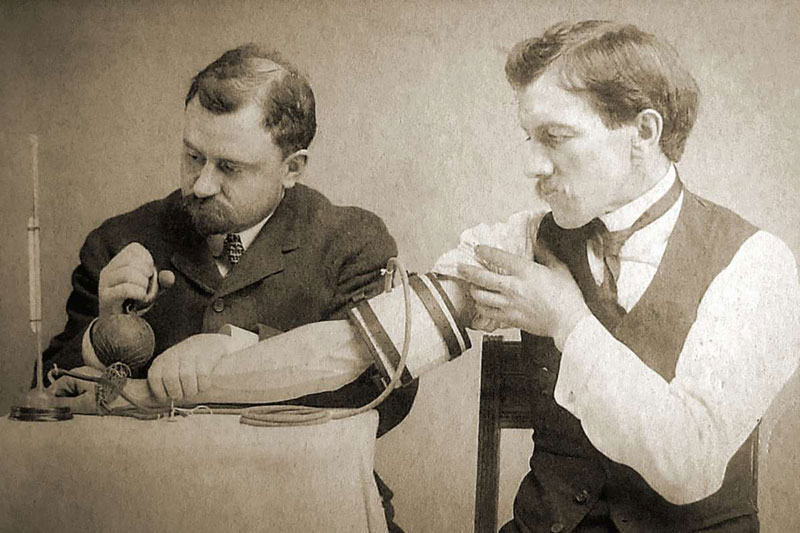 BP measurement is a 20th century metric.
BP measurement is a 20th century metric.
By this time—coincidentally, at around the same time the American public began to become more aware of weight-training and bodybuilding as a means to health—it was also understood that
heavy exercise increases blood pressure, while you are performing it. Normal systolic blood pressure (the pressure when your heart beats) can actually almost
double during hard training.
There are several mechanisms behind this. Simple physics is one reason—if you tense your muscles, the circulatory system becomes constricted. The "pipework" gets smaller, and since the volume of blood in the system doesn’t change, therefore the pressure increases (Poiseuille's law). In addition, exercises increase heart rate and oxygen demand; if the heart is pumping blood around the system
harder, system pressure will obviously rise. There is also an increase in the activity of the sympathetic nervous system during exercise, which boosts BP.
1
You can guess what happened next. Many physicians put together two and two and came up with
five. Since
high blood pressure is bad, and
exercising raises blood pressure—then exercising must be bad. Right?
Wrong. Dead wrong.
Blood pressure, isometrics and exercise
A key feature of blood pressure is that it fluctuates all the time. It’s meant to. Your BP rises when you cough, when you visit the bathroom, when you laugh. Sudden rises in blood pressure are not only normal, they are absolutely essential to human functioning. If your blood pressure didn’t rise, you’d collapse and lose consciousness when you tried to stand up (this happens all the time to people with low BP—their blood pressure doesn’t rise enough).
These brief, fluctuating periods of high blood pressure are generally not a danger to health. Blood pressure spikes with exercise, just like your heart rate does. This is not a problem in either case, because when you cease activity, both BP and heart rate return to their resting baseline level. The real danger of high blood pressure (and heart rate) occurs when your resting, baseline level is high. You may only exercise for an hour per day, but if your resting BP is high, your circulatory system has to deal with it 24 hours per day. This is when we see strokes, aneurisms and heart attacks—when BP is consistently raised over months and years. The brief spikes caused by exercise are not the problem. In fact, comprehensive analysis proves that heavy exercise can cure hypertension (high blood pressure), rather than worsen it.2
Almost all physicians now acknowledge the power of working out to reduce high blood pressure. What fewer physicians realize is that isometric training is even more powerful than regular weight-training in reducing high blood pressure (in fact, it’s more powerful than any training methodology for this purpose).
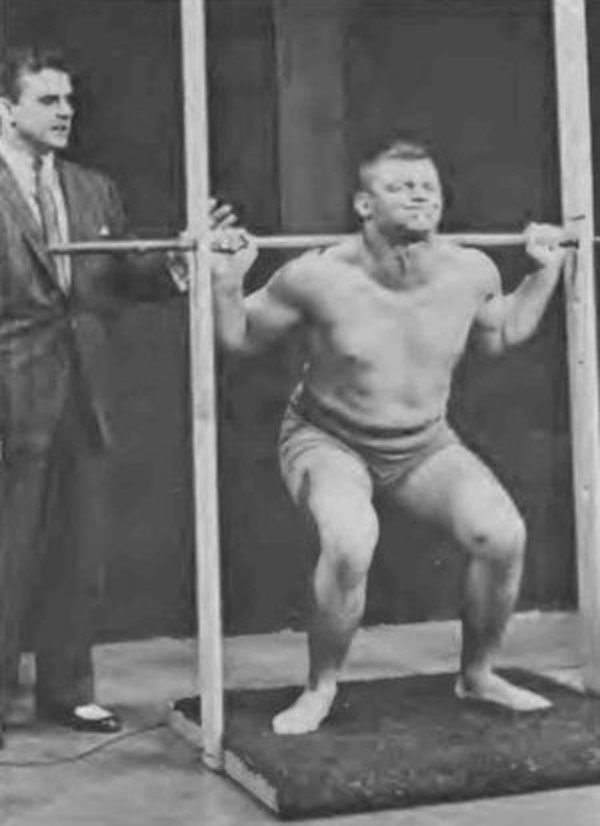 We now understand that training hard can reduce high blood pressure effectively.
We now understand that training hard can reduce high blood pressure effectively.Some hardcore isometrics from the Golden Age.
After researchers had thoroughly studied the effects of conventional weight-training on BP, a few bright sparks decided to look at isometrics in the same light. It was assumed at the time that isos might have a similar effect to weights work on reducing high resting blood pressure. In fact, the results of the isometrics studies were shocking. Isos are much, much better than regular weight-training for reducing BP; and after four decades of strenuous research, the jury is finally in. A cutting-edge meta-analysis of 270 studies carried out worldwide over the last thirty years shows that not only does isometrics reduce resting blood pressure, it does so better than any other form of exercise. The researchers examined lifting weights, aerobics (running, cycling, etc.), combined training (weights and aerobics), high-intensity training (like sprints) and isometric strength exercises:
While all five programs reduced blood pressure, isometric exercises were the most effective, followed by combined training, resistance training, aerobic exercise, and HIIT.3
Did you get that? If you’re walking, jogging, cycling, lifting weights or sprinting to reduce your blood pressure, stop. Start doing isometrics instead.
In one study individuals performing isometric exercises three times per week over eight weeks saw their systolic pressure drop by 12.5 points, and their diastolic plunge by a huge 14.9 points—that’s nearly two points per week.4 This is a huge, potentially life-saving drop—with a low amount of training (only around twenty minutes, three times per week) in a relatively short span of time. In fact, benefits may come even quicker than that—more recent studies have noted significant blood pressure drops from as little as four weeks of isometric training.5 Isometrics in many cases is more effective than antihypertensive medication and has been suggested by some experts as an alternative.6
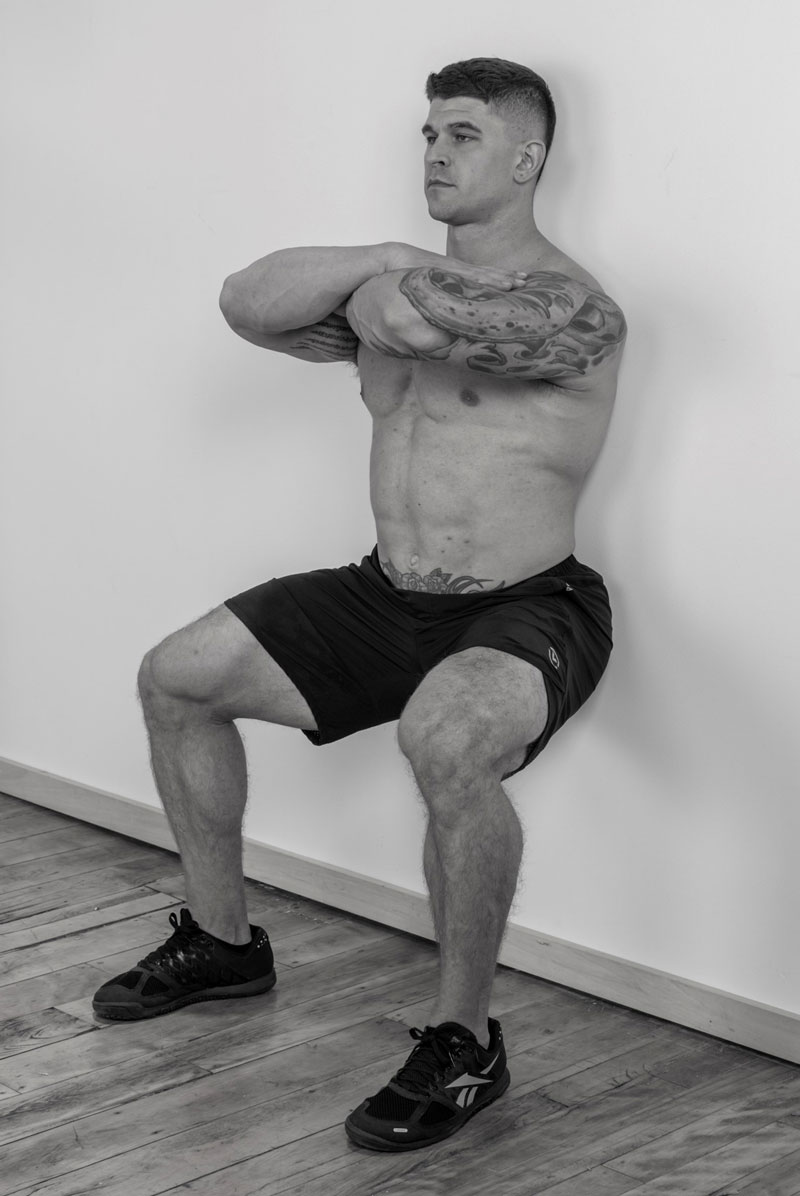 An example of a wall sit—what we used to call "Samson's Seat".
An example of a wall sit—what we used to call "Samson's Seat".
Reducing high
resting BP sounds amazing—but what about the risk of stroke or heart attack
while training? According to a recent article in the respected journal
Clinical Hypertension, you shouldn’t worry. Isometrics are not only safe to perform for this purpose, they also reduce the practitioner’s risk of cardiovascular events:
A rapidly expanding evidence base indicates isometric resistance training to be very effective for managing hypertension. There is no published data suggesting isometric resistance training is unsafe…Published data in potentially high-risk populations (e.g., heart failure) shows relevant benefits beyond BP lowering (e.g., improved endothelial and collateral vessel function). The size of BP reductions which have consistently been shown equate to > 10% myocardial infarction and > 20% stroke reductions.7
In fact, isometric strength training is so safe to perform, it has recently been endorsed by the American College of Cardiology/American Heart Association Task Force on Clinical Practice Guidelines.
8
The isometric response
Why is isometrics so great for normalizing blood pressure? The answer has to do with the
isometric response. Here’s how it’s described in
The Ultimate Isometrics Manual:
Essentially, when you squeeze your muscles and hold that position—as in isometrics—your blood vessels become mechanically constricted by the tight muscles. As a result, the entire cardiovascular system has to work much harder to pump blood around the body. This, in turn, gives the heart and blood vessels a powerful workout. This might be termed the cardiovascular isometric response, and researchers are beginning to understand that it has major potential benefits for heart health.
Essentially, isometrics is a supercharged workout for your heart which also tones and strengthens the tissues of your circulatory system; an effect which not only results in a dramatic lowering of high blood pressure, but also an increase in heart health and all-round cardiovascular fitness.
9 Isometrics really is a workout for your circulatory system as much as for your muscles.
If you take just one thing away from this article, please make it this:
far from being "bad" for your blood pressure, isometric strength training normalizes high blood pressure—faster than any other form of exercise, and even faster than medications. In fact, it may be the best possible activity you can do for your blood pressure!
Practical tips
Where do you go from here? First up, before any strenuous exercise program, always get your doc’s okay—that’s true for isometrics, weight-training, running, rowing, anything.
From thereon in, if your BP is high and you want to improve it, a good place to begin would be with sixty seconds of total isometrics every other day. This needn’t be complicated, and it can be an equipment-free work. An example might be:
- Wall sit – 20 seconds
- Plank – 20 seconds
- Doorway press – 20 seconds
Over time, build to 120 seconds. Start light—don’t do anything too hard the first few sessions. Try to vary your exercises every so often, to prevent physiological accommodation.
The Ultimate Isometrics Manual has the world’s finest collection of zero-tech isos for you to try.
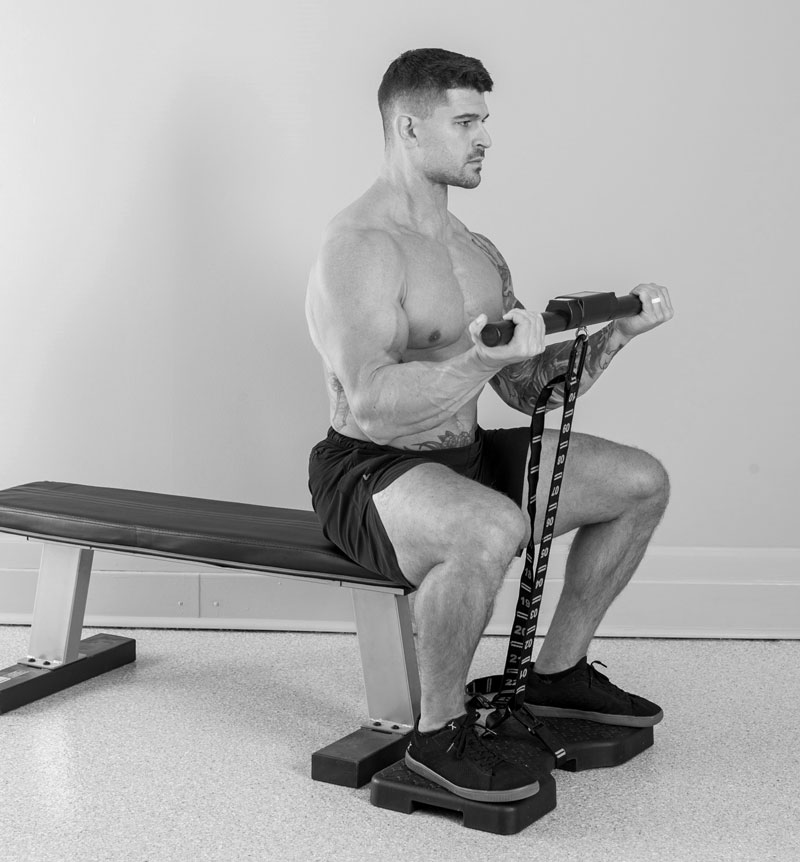 The Isomax accurately measures training forces, training time, and even tells you when to quit. Described by coaches as the most foolproof method of resistance training on the planet!
The Isomax accurately measures training forces, training time, and even tells you when to quit. Described by coaches as the most foolproof method of resistance training on the planet!
Beyond that, if you wish to evolve your isometric fitness, you will need to start
measuring your force levels and improving on them over any given time. This will require equipment like an
Isomax, which the Dragon Door team designed to be digitally accurate and user-friendly. I’m convinced that the use of this device is the fastest and safest way to bring down dangerously high blood pressure to the "safety zone" in as little as a few weeks. The only serious side-effects to a program of Isomax exercises are:
- Improved strength
- Increased muscle size
- Reduced joint pain
- Amplified speed and explosiveness
And a ton of other great benefits you can read about
here.
…What have you got to lose, but weakness?
References:
- Mohammed, L. L. M., Dhavale, M., Abdelaal, M. K., Alam, A. B. M. N., Blazin, T., Prajapati, D., & Mostafa, J. A. (2020). Exercise-Induced Hypertension in Healthy Individuals and Athletes: Is it an Alarming Sign? Cureus, 12(12), e11988.
- Correia, R.R., Veras, A.S.C., Tebar, W.R. et al. (2023). Strength training for arterial hypertension treatment: a systematic review and meta-analysis of randomized clinical trials, Scientific Reports, 13, 201.
- Can wall squats and planks lower your blood pressure? Bhf.org.uk
- Wiley, R. L. et al. (1992). Isometric Exercise Training Lowers Resting Blood Pressure, Medicine and Science in Sports and Exercise, Jul; 24(7)
- Devereux, G. R. et al. (2010). Reductions in Resting Blood Pressure After 4 Weeks of Isometric Exercise Training, European Journal of Applied Physiology, Jul; 109(4)
- Sandhu, J. S. et al. (2014). Effect of Isometric Handgrip Training on Heart Rate and Arterial Pressure in Normotensive Individuals, Scholars Journal of Applied Medical Sciences, vol. 2
- Baffour-Awuah, B., Pearson, M.J., Dieberg, G. et al. (2023). An evidence-based guide to the efficacy and safety of isometric resistance training in hypertension and clinical implications, Clinical Hypertension, 29(9).
- Whelton PK, Carey RM, Aronow WS, Casey DE Jr, Collins KJ, Dennison Himmelfarb C, et al. (2018). ACC/AHA/AAPA/ABC/ACPM/AGS/APhA/ASH/ASPC/NMA/PCNA guideline for the prevention, detection, evaluation, and management of high blood pressure in adults: a report of the American College of Cardiology/American Heart Association Task Force on Clinical Practice Guidelines, Journal of the American College of Cardiology, 71, e127-248.
- Sandhu, J. S. et al. (2014). Effect of Isometric Handgrip Training on Heart Rate and Arterial Pressure in Normotensive Individuals, Scholars Journal of Applied Medical Sciences, 2
Back